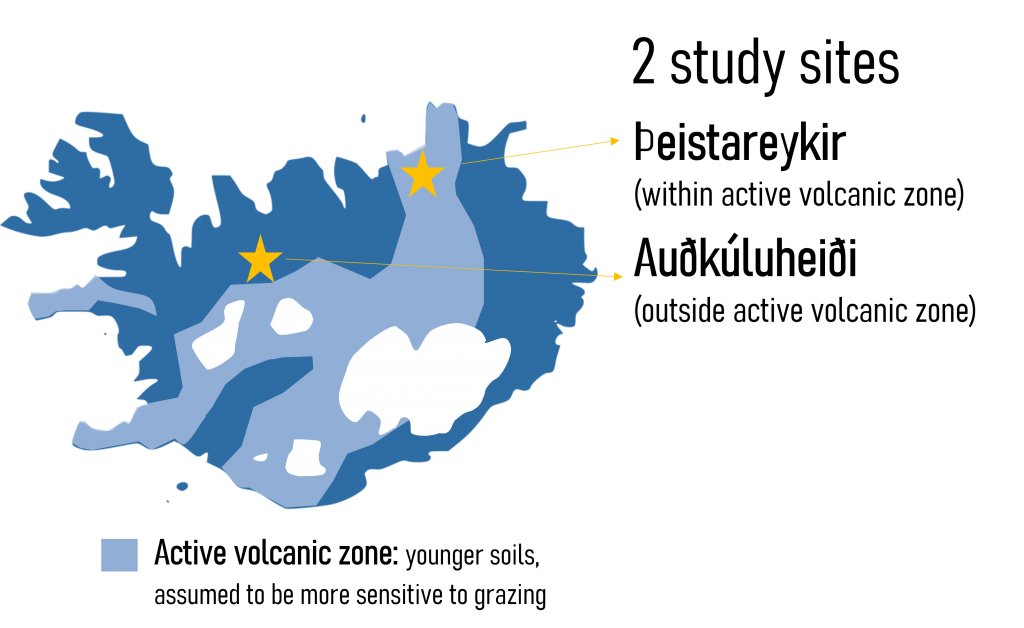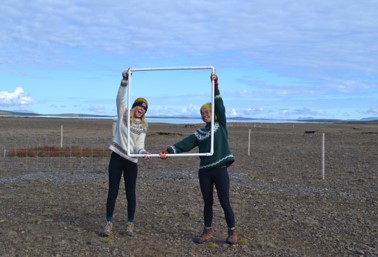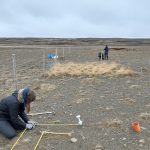In 2016 we set up a field experiment at two sites in the highlands in Iceland to assess the impact of sheep grazing on summer rangelands. The experiment was established at two sites that differ in their susceptibility to soil erosion. The basis of site and habitat selection lays on two of the main features that determine the ecological conditions in Iceland: volcanic activity and vegetation cover.

Even though most of the soils in Iceland are of volcanic nature, only one part of the island is currently volcanically active. Taking this into account, we chose two sites based on their position relative to the active volcanic zone, which runs through the country form the south-west to the north-east: Þeistareykir lies within the active volcanic zone and Auðkúluheiði is outside the active volcanic zone.
On the other hand, one of the most relevant classifications of Icelandic soils relies on the differences in vegetation cover, sorting them into desert soils (vitric soils) and soils under vegetation (histosols). The main difference between them is that the histosols have more carbon and allophane than vitrisols, which deeply conditions their fertility. Following that approach, we selected at each site two habitats with contrasting vegetation cover: dwarf-shrub heath and gravelly desert (melur).
- Dwarf shrub heath: the vegetation cover reaches more than 90% of the surface and is comprised mostly by low statured shrubs, mainly Betula nana.
- Melur (gravelly desert): it has less than 10% vegetation cover, mostly integrated by forbs (mainly Arabidopsis petraea and Silene uniflora) and grasses.
Melur and heath represent the two extremes in terms of soil erosion, melur being exposed and at high risk of soil erosion, and heath holding more vegetation that reduces its risk of erosion. These two habitat types are prevalent throughout most of the highlands of Iceland.
In 2016 we set up six pairs of plots (12 x 12 m) in each of the two habitats (24 plots per site), at each site. Plots within each pair were randomly assigned to a fencing treatment. One plot of each pair was protected from grazing by fencing (120 cm high, regular livestock fence), while the other one (control) was left open to sheep grazing. The plots in each pair were situated adjacent to each other (separated 6 m). Each pair was separated from the next one by at least 100 m.

Monitoring and add-on projects
- Fertilization experiment (NutNet)
- TeaBag Index
- SoilTemp initiative
- MycoFTE
- Snow monitoring
- Disturbance experiment
- CO2 respiration
- Long-term vegetation monitoring
- Invertebrate sampling
- Seed rain
Publications
- Kushbokov, A.U., Barrio, I.C. and Jónsdóttir, I.S. (2023) Estimating the effects of grazing exclusion on the seed bank in Icelandic rangelands. Icelandic Agricultural Sciences 36: 35-40 https://doi.org/10.16886/IAS.2023.03
- Ladouceur, E., Blowes, S.A., Chase, J.M., Clark, A.T., Garbowski, M., Alberti, J., Arnillas, C.A., Bakker, J.D., Barrio, I.C., Bharath, S., Borer, E.T., Brudvig, L.A., Cadotte, M.W., Chen, Q., Collins, S.L., Dickman, C.R., Donohue, I., Du, G., Ebeling, A., Eisenhauer, N., Fay, P.A., Hagenah, N., Hautier, Y., Jentsch, A., Jónsdóttir, I.S., Komatsu, K., MacDougall, A., Martina, J.P., Moore, J.L., Morgan, J.W., Peri, P.L., Power, S.A., Ren, Z., Risch, A.C., Roscher, C., Schuchardt, M.A., Seabloom, E.W., Stevens, C.J., Veen, G.F., Virtanen, R., Wardle, G.M., Wilfahrt, P.A., Harpole, W.S. (2022) Linking changes in species composition and biomass in a globally distributed grassland experiment. Ecology Letters.
- Price, J., Sitters, J., Ohlert, T., Tognetti, P., Brown, C., Seabloom, E., Borer, E., Prober, S., Bakker, E., Macdougall, A., Yahdjian, L., Gruner, D., Olde Venterink, H., Barrio, I.C., Graff, P., Bagchi, S., Arnillas, C., Bakker, J., Blumenthal, D., Boughton, E., Brudvig, L., Bugalho, M., Cadotte, M. , Caldeira, M., Dickman, C., Donohue, I., Grégory, S., Hautier, Y., Jónsdóttir, I.S., Lannes, L., Mcculley, R., Moore, J., Power, S., Risch, A., Schultz, M., Standish, R., Stevens, C., Veen, C., Virtanen, R., Wardle, G. (2022) Evolutionary history of grazing and resources determine herbivore exclusion effects on plant diversity. Nature Ecology & Evolution, 6(9):1290-1298.
- Vuorinen, K., Austrheim, G., Tremblay, J.-P., Myers-Smith, I.H., Hortman, H.I., Frank, P., Barrio, I.C., Dalerum, F., Björkman, M.P., Björk, R.G., Ehrich, D., Sokolov, A., Sokolova, N., Ropars, P., Boudreau, S., Normand, S., Prendin, A.L., Schmidt, N.M., Pacheco, A., Post, E., John, C., Kerby, J.T., Sullivan, P.F., Le Moullec, M., Hansen, B.B., Van der Wal, R., Pedersen, Å.Ø., Sandal, L., Gough, L., Young, A., Li, B., Magnússon, R.Í., Sass-Klaassen, U., Buchwal, A., Welker, J.M., Grogan, P., Andruko, R., Morrissette-Boileau, C., Volkovitskiy, A., Terekhina, A., Speed, J.D.M. (2022) Growth rings show limited evidence for ungulates’ potential to suppress shrubs across the Arctic. Environmental Research Letters 17:034013
- Mulloy, T.A., Barrio, I.C., Jónsdóttir, I.S., Hik, D.S. (2021) The effects of different management interventions on degraded rangelands in Iceland. Land Degradation & Development 32(16):4583-4594 pdf
- Seabloom, E.W., Batzer, E., Chase, J.M., Harpole, W.S., Adler, P.B., Bagchi, S., Bakker, J.D., Barrio, I.C., Biederman, L., Boughton, E.H., Bugalho, M.N., Caldeira, M.C., Catford, J.A., Daleo, P., Eisenhauer, N., Eskelinen, A., Haider, S., Hallett, L.M., Jónsdóttir, I.S., Kimmel, K., Kuhlman, M., MacDougall, A., Molina, C.D., Moore, J.L., Morgan, J.W., Muthukrishnan, R., Ohlert, T., Risch, A.C., Roscher, C., Schütz, M., Sonnier, G., Tognetti, P.M., Virtanen, R., Wilfahrt, P.A., Borer, E.T. (2021) Species loss due to nutrient addition increases with spatial scale in global grasslands. Ecology Letters 24(10):2100-2112 pdf
- Mulloy, T.A., Barrio, I.C., Björnsdóttir, K., Jónsdóttir, I.S., Hik, D.S. (2019) Fertilizers mediate the short-term effects of sheep grazing in the Icelandic highlands. Icelandic Agricultural Sciences 32:75-85 pdf
Theses and reports
- Ólafsdóttir, A.B. (2023) Structure and functional diversity of microbial communities in tundra soils in different degrees of degradation. MSc thesis, University of Iceland pdf
- Erludóttir, U.L. (2023) Living in the moss: mesofaunal communities of Racomitrium lanuginosum in Icelandic rangelands. BSc thesis, Agricultural University of Iceland pdf
- Qo´shboqov, A. (2022) Identification of land potential by seed banks under sheep grazing in the Icelandic highlands. GRÓ Land Restoration Training Programme [final project] pdf
- Olupot, I. (2022) Using the tea bag index to measure decomposition rates in Icelandic rangelands. GRÓ Land Restoration Training Programme [final project] pdf
- Jónasdóttir, H.L. (2021) Response of plant functional groups to grazing exclusion and fertilization in the Icelandic highlands. BSc thesis, Agricultural University of Iceland pdf
- Mulloy, T.A. (2020) Effects of nutrient addition and sheep grazing on tundra rangelands in the Icelandic highlands. MSc thesis, Simon Fraser University pdf
- Björnsdóttir, K. (2018) Decomposition responses to climate warming and sheep grazing in the high and sub-Arctic. MSc thesis, University of Iceland pdf
- Akello, G. (2019) Response of Icelandic soils to grazing exclusion. United Nations University Land Restoration Training Programme [final project] pdf
- Watson-Savage, C.I. (2018) Examining the role of grazing on Icelandic entomofauna. BSc thesis, Dalhousie University
- Sierro-Miguel, P. (2017) Impacts of sheep grazing on germinable seeds in the Icelandic Highlands. BSc thesis, University of Iceland pdf
- Mulloy, T.A. (2017) Effects of fertilization treatments on tundra ecosystems in the Icelandic highlands. BSc thesis, Dalhousie University
Latest news
- New paper on soil seed banks in Icelandic rangelands
 Abdubakir Kushbokov‘s study on the effects of grazing exclusion in the Icelandic rangelands has now been published in the journal Icelandic Agricultural Sciences.
Abdubakir Kushbokov‘s study on the effects of grazing exclusion in the Icelandic rangelands has now been published in the journal Icelandic Agricultural Sciences. - Successful main field season at the FENCES sites
 The main field campaign at the FENCES sites took place Jul 31 to Aug 8. Very good weather and very effective field team, so we got everything done really quickly!
The main field campaign at the FENCES sites took place Jul 31 to Aug 8. Very good weather and very effective field team, so we got everything done really quickly! - Starting the field season at the FENCES sites
 Our first field visit of 2021 to the FENCES sites was on June 19-21. The spring is a bit late this year – everything was still brown and the dwarf birch was only shyly starting to leaf. As usual in our first annual visit we had many things to do, getting ready for the summer!…
Our first field visit of 2021 to the FENCES sites was on June 19-21. The spring is a bit late this year – everything was still brown and the dwarf birch was only shyly starting to leaf. As usual in our first annual visit we had many things to do, getting ready for the summer!…
Funding and support
This project was funded through a postdoctoral fellowship to Dr Isabel C Barrio from Rannís and AXA Research Fund, a grant from the University of Iceland Research Fund (2015) to Dr Ingibjörg Svala Jónsdóttir, and the Soil Conservation Service of Iceland. Monitoring at the sites during 2017-2019 was supported by funding from Orkurannsónknasjóður Landsvirkjunar (NÝR-09-2017, NÝR-14-2018, NÝR-12-2019).